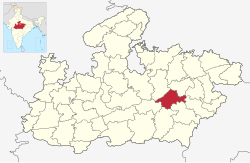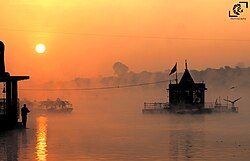Jabalpur district
Jabalpur district | |
|---|---|
Clockwise from top-left: Madan Mahal in Jabalpur, Chausath Yogini Temple, Bhedaghat, Dumna Nature Reserve Park, sunrise at Gwarighat, Dhuandhar Falls | |
 Location of Jabalpur district in Madhya Pradesh | |
| Country | |
| State | Madhya Pradesh |
| Division | Jabalpur |
| Headquarters | Jabalpur |
| Government | |
| • Lok Sabha constituencies | Jabalpur |
| Area | |
• Total | 5,198 km2 (2,007 sq mi) |
| Population (2011) | |
• Total | 2,463,289 |
| • Density | 470/km2 (1,200/sq mi) |
| Demographics | |
| • Literacy | 82.47% |
| • Sex ratio | 925 females/1000 males |
| Time zone | UTC+05:30 (IST) |
| Website | jabalpur |
Jabalpur district (Hindi pronunciation: [d͡ʒəbəlpʊɾ]) is a district of Madhya Pradesh state in central India. The city of Jabalpur is the administrative headquarters of the district.
The area of the district is 5,198 km2[1] with population of 2,463,289 (2011 census). As of 2011 it is the second most populous district of Madhya Pradesh (out of 50), after Indore.[2]
Jabalpur district is located in the Mahakoshal region of Madhya Pradesh, on the divide between the watersheds of Narmada and the Son, but mostly within the valley of the Narmada, which here runs through the famous gorge known as the Marble rocks, and falls 30 ft. over a rocky ledge (the Dhuan Dhar, or misty shoot ). It consists of a long narrow plain running north-east and south-west and shut in on all sides by highlands. This plain, which forms an offshoot from the great valley of the Narmada, is covered in its western and southern portions by a rich alluvial deposit of black cotton soil. At Jabalpur city, the soil is black cotton soil, and water plentiful near the surface. The north and east belong to the basin of the Son River, a tributary of the Ganges and Yamuna, the south and west to the Narmada basin. The district is traversed by the main railway from Mumbai to Kolkata, and by branches of two other lines which meet at Katni junction.[3]
Geography
[edit]The district is part of Jabalpur Division. It has an average elevation of 411 metres (1348 ft).
Sub Divisions
[edit]Climate
[edit]| Climate data for Jabalpur Airport (1981–2010, extremes 1901–2011) | |||||||||||||
|---|---|---|---|---|---|---|---|---|---|---|---|---|---|
| Month | Jan | Feb | Mar | Apr | May | Jun | Jul | Aug | Sep | Oct | Nov | Dec | Year |
| Record high °C (°F) | 33.4 (92.1) | 37.6 (99.7) | 41.1 (106.0) | 45.4 (113.7) | 46.7 (116.1) | 46.1 (115.0) | 41.7 (107.1) | 38.4 (101.1) | 35.8 (96.4) | 37.9 (100.2) | 35.8 (96.4) | 33.2 (91.8) | 46.7 (116.1) |
| Mean daily maximum °C (°F) | 24.6 (76.3) | 27.8 (82.0) | 33.4 (92.1) | 38.5 (101.3) | 41.1 (106.0) | 37.7 (99.9) | 31.3 (88.3) | 29.8 (85.6) | 31.1 (88.0) | 31.7 (89.1) | 28.9 (84.0) | 25.7 (78.3) | 31.8 (89.2) |
| Mean daily minimum °C (°F) | 10.6 (51.1) | 13.2 (55.8) | 17.8 (64.0) | 22.9 (73.2) | 27.1 (80.8) | 26.8 (80.2) | 24.6 (76.3) | 24.0 (75.2) | 23.5 (74.3) | 20.0 (68.0) | 14.5 (58.1) | 10.8 (51.4) | 19.6 (67.3) |
| Record low °C (°F) | 1.1 (34.0) | 0.0 (32.0) | 3.3 (37.9) | 10.6 (51.1) | 17.2 (63.0) | 19.0 (66.2) | 20.6 (69.1) | 18.3 (64.9) | 16.7 (62.1) | 6.8 (44.2) | 3.9 (39.0) | 0.6 (33.1) | 0.0 (32.0) |
| Average rainfall mm (inches) | 21.9 (0.86) | 24.6 (0.97) | 14.9 (0.59) | 4.8 (0.19) | 11.4 (0.45) | 168.0 (6.61) | 376.6 (14.83) | 401.9 (15.82) | 220.9 (8.70) | 30.2 (1.19) | 10.1 (0.40) | 6.0 (0.24) | 1,291.4 (50.84) |
| Average rainy days | 1.8 | 1.6 | 1.2 | 0.5 | 1.2 | 7.4 | 14.3 | 14.9 | 9.0 | 2.0 | 0.7 | 0.6 | 55.2 |
| Average relative humidity (%) (at 17:30 IST) | 49 | 37 | 25 | 19 | 21 | 47 | 73 | 79 | 70 | 53 | 51 | 51 | 48 |
| Source: India Meteorological Department[4][5] | |||||||||||||
Demographics
[edit]| Year | Pop. | ±% p.a. |
|---|---|---|
| 1901 | 430,810 | — |
| 1911 | 472,102 | +0.92% |
| 1921 | 471,951 | −0.00% |
| 1931 | 489,583 | +0.37% |
| 1941 | 576,167 | +1.64% |
| 1951 | 662,569 | +1.41% |
| 1961 | 821,579 | +2.17% |
| 1971 | 1,119,885 | +3.15% |
| 1981 | 1,484,235 | +2.86% |
| 1991 | 1,768,037 | +1.77% |
| 2001 | 2,151,203 | +1.98% |
| 2011 | 2,463,289 | +1.36% |
| source:[6] | ||
According to the 2011 census Jabalpur district has a population of 2,463,289[2] roughly equal to the nation of Kuwait[7] or the US state of Nevada.[8] This gives it a ranking of 180th in India (out of a total of 640).[2] The district has a population density of 472 inhabitants per square kilometre (1,220/sq mi).[2] Its population growth rate over the decade 2001-2011 was 14.39%.[2] Jabalpur has a sex ratio of 925 females for every 1000 males,[2] and a literacy rate of 82.47%. 58.46% of the population lives in urban areas. Scheduled Castes and Tribes made up 14.13% and 15.23% of the population respectively.[2]
Hindus are majority religion in Jabalpur district with 87.65%, Muslims with 8.27% and rest of Jains, Sikhs and Christians.[9]
Languages
[edit]At the time of the 2011 Census of India, 94.21% of the population in the district spoke Hindi and 1.93% Urdu as their first language.[10]
The dialect of the region is Baghelkhandi. Other languages spoken in the district by a significant number of people in the district include Marathi, Punjabi, Sindhi and Bengali, almost exclusively in Jabalpur city.
Education
[edit]Jabalpur is an important educational centre of the Madhya Pradesh state. Jabalpur has Rani Durgavati University, Jawahar Lal Nehru Krishi University, Madhya Pradesh Pashu Chikitsa University, Netaji Subhash Chandra Bose Medical College, Dharmashastra National Law University Madhya Pradesh Ayurvigyan University and Maharshi Mahesh Yogi Vedic University. Good educational institutes in Jabalpur include Govt. Engineering College, Medical College, Government M.H. College of Home Science and Science, Law Colleges, Post Graduate and under-Graduate Colleges. The Indian Institute of Information Technology, Design & Manufacturing (IIITDM) Jabalpur was established in January 2005. Institute would serve as an inter-disciplinary institution for education and research by keeping the concept of Product Lifecycle Management (PLM) in mind.
It has some very reputed and old schools. Some of the schools like Pandit Lajja shankar jha government modal higher secondary excellence school are more than a century old. Apart from these educational institutions there a number of institutes offering various professional courses in Computers, Fashion Designing, Fine Arts etc.
Tourist places
[edit]- Dhuadhar water fall
- Madan Mahal fort
- Dumna Nature Resurve Park
- Bargi Dam
See also
[edit]References
[edit]- ^ Krishi Vigyan Kendra, Jabalpur
- ^ a b c d e f g "District Census Handbook: Jabalpur" (PDF). Census of India. Registrar General and Census Commissioner of India. 2011.
- ^ One or more of the preceding sentences incorporates text from a publication now in the public domain: Chisholm, Hugh, ed. (1911). "Jubbulpore". Encyclopædia Britannica. Vol. 15 (11th ed.). Cambridge University Press. p. 532.
- ^ "Station: Jabalpur Climatological Table 1981–2010" (PDF). Climatological Normals 1981–2010. India Meteorological Department. January 2015. pp. 339–340. Archived from the original (PDF) on 5 February 2020. Retrieved 28 December 2020.
- ^ "Extremes of Temperature & Rainfall for Indian Stations (Up to 2012)" (PDF). India Meteorological Department. December 2016. p. M120. Archived from the original (PDF) on 5 February 2020. Retrieved 28 December 2020.
- ^ "Table A-02 Decadal Variation in Population Since 1901: Madhya Pradesh" (PDF). census.gov.in. Registrar General and Census Commissioner of India.
- ^ US Directorate of Intelligence. "Country Comparison:Population". Archived from the original on 13 June 2007. Retrieved 1 October 2011.
Kuwait 2,595,62
- ^ "2010 Resident Population Data". U. S. Census Bureau. Archived from the original on 19 October 2013. Retrieved 30 September 2011.
Nevada 2,700,551
- ^ a b "Table C-01 Population By Religion: Madhya Pradesh". census.gov.in. Registrar General and Census Commissioner of India.
- ^ a b "Table C-16 Population by Mother Tongue: Madhya Pradesh". censusindia.gov.in. Registrar General and Census Commissioner of India.


 French
French Deutsch
Deutsch



